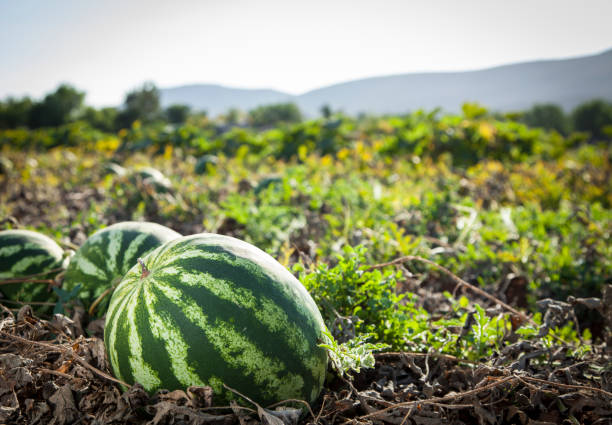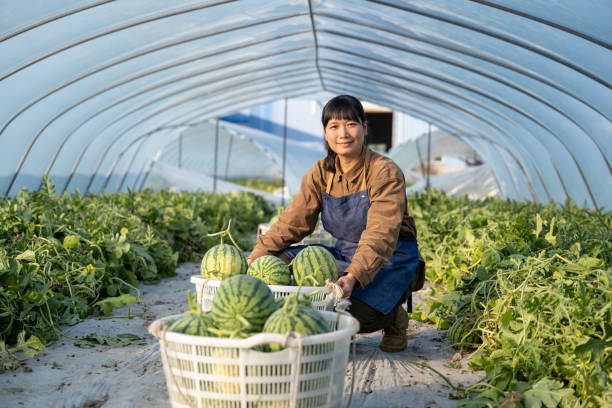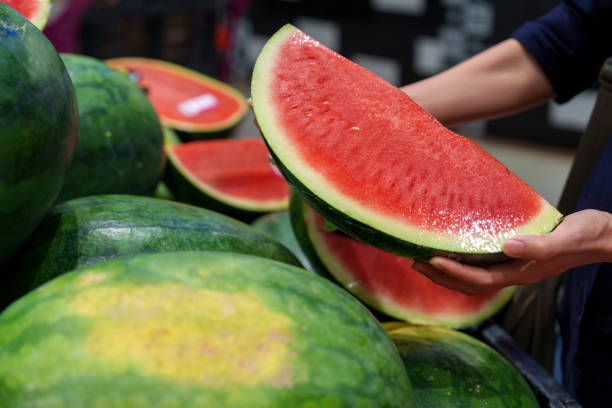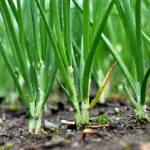
Achieve a good harvest of watermelons with a seed
As the temperature begins to rise, there’s nothing quite like the satisfying burst of sweetness from a freshly cut slice of home-grown watermelon. This quintessential summer fruit is not only a crowd-pleaser at barbecues and picnics but also a refreshing treat on a scorching hot day. When grown at home, the flavor is incomparably better than store-bought ones. With a sunny spot in your yard and a few seeds, you too can taste the difference. Let’s dive into the comprehensive guide on how to grow watermelons that are rich in taste and bursting with juice.
Identifying Your Preferred Watermelon Variety

To begin this gratifying journey of growing luscious watermelons, it’s crucial to identify the type of watermelon you wish to cultivate. Three primary varieties exist: Early-season, main-season, and seedless watermelons. Each category offers flesh colors ranging from traditional red to eye-catching pink, vibrant orange, and mellow yellow.
The early-season, also known as an icebox melon, is conveniently sized to fit on a refrigerator shelf. It ripens the fastest, maturing in approximately 70 to 75 days. On the other hand, the main-season watermelon is more substantial in size, requiring around 80 to 90 days to reach maturity.
A fascinating play of plant genetics results in the creation of seedless watermelons. Despite the inability to produce seeds, these watermelon plants can fruit if their blossoms get pollinated from seeded watermelons nearby. With their energy not spent on seed production, these seedless varieties often bear sweeter fruit, and their vines remain vigorous throughout summer.
Choosing the Perfect Time to Plant Watermelons
In colder climates, the growing season may not be long enough to yield a fruitful harvest from seeds. If this is the case, start your watermelon seeds indoors, about two to three weeks before your region’s last frost. Use a soilless potting mix to plant the seeds and keep them warm and moist until the outdoor temperatures consistently stay above 50°F.
Be cautious not to start the process too early, as larger plants don’t transplant well into the garden. Watermelons prefer their roots undisturbed. Direct sowing into the ground is also possible when the soil temperature exceeds 65°F. Sow seeds 1/2 to 1 inch deep, placing two or three seeds in clusters 18 to 24 inches apart. Upon establishment, thin out weaker seedlings, retaining the most vigorous watermelon plant in each group.
Creating the Ideal Environment for Watermelon Growth

Creating the ideal environment for watermelon growth involves considering key factors such as climate, sunlight, soil, and water.
Watermelons thrive in warm climates and require a long, warm growing season. Optimal temperatures range from 70°F (21°C) to 90°F (32°C). Ensure that your growing region provides these temperatures throughout the watermelon’s growth cycle. In cooler regions, you can utilize protective structures like greenhouses or row covers to create a warmer microclimate.
Sunlight is essential for watermelon plants. Choose a planting location that receives full sun exposure, ideally 6-8 hours of direct sunlight per day. Adequate sunlight promotes photosynthesis, leading to healthy growth and optimal fruit development.
The soil plays a vital role in watermelon cultivation. Watermelons prefer well-draining, loamy soil with a pH range of 6.0 to 7.0. Before planting, prepare the soil by removing weeds and incorporating organic matter such as compost or well-rotted manure. This improves soil fertility, structure, and water retention.
Watermelons have high water requirements, especially during hot summer months. Provide consistent and deep watering to keep the soil evenly moist. Avoid waterlogging, as it can lead to root rot. Applying a layer of mulch around the plants helps retain soil moisture, suppresses weeds, and regulates soil temperature.
Proper spacing is important for watermelon plants. Allow enough room between plants to promote airflow and prevent overcrowding, which can increase the risk of diseases. Adequate spacing also allows the vines to spread and bear fruit more effectively.
Consider the use of trellises or supports for vining watermelon varieties. These structures help lift the fruit off the ground, prevent rotting, and provide better air circulation around the plants.
In addition to these factors, regular monitoring for pests and diseases is crucial. Implement preventive measures such as crop rotation, proper sanitation, and organic pest control methods to maintain the health of your watermelon plants.
By considering these environmental factors and providing the optimal conditions of warmth, sunlight, well-draining soil, adequate water, and proper spacing, you can create an ideal environment for watermelon growth. This will promote vigorous plant growth, abundant fruit production, and ultimately, flavorful and juicy watermelons for your enjoyment.
Understanding the Role of Pollination in Watermelon Cultivation

Understanding the Role of Pollination in Watermelon Cultivation
Pollination plays a crucial role in watermelon cultivation as it directly influences fruit development and quality. Watermelons are angiosperms, meaning they rely on pollination to transfer pollen from the male flowers to the female flowers, ultimately leading to the production of fruit. Here’s a closer look at the role of pollination in watermelon cultivation:
- Male and Female Flowers:
Watermelon plants produce separate male and female flowers. Male flowers possess stamens, which consist of a filament and anther that produce pollen. Female flowers, on the other hand, have a stigma, style, and ovary. The ovary is where the fruit develops if pollination occurs successfully. - Pollinators:
Watermelons rely on pollinators, particularly bees, to transfer pollen from the male flowers to the female flowers. Bees are attracted to the bright yellow color of the watermelon flowers and collect nectar from them. As they move from flower to flower, they inadvertently transfer pollen, facilitating pollination. - Self-Incompatibility and Cross-Pollination:
Watermelons exhibit self-incompatibility, which means that pollen from the same plant or variety cannot fertilize the female flowers effectively. To overcome this, watermelon plants benefit from cross-pollination, where pollen from one variety is transferred to the female flowers of a different variety. Therefore, it is beneficial to have multiple watermelon plants or different varieties planted nearby to encourage cross-pollination. - Maximizing Pollination Success:
To maximize pollination success in watermelon cultivation, there are several practices you can follow: a. Attract Pollinators: Create a pollinator-friendly environment by planting flowers that attract bees and other pollinators nearby. These flowers act as a food source and encourage pollinator activity in your garden. b. Avoid Pesticide Use During Flowering: Minimize or avoid pesticide use, especially during flowering, to prevent harm to pollinators. c. Provide Shelter: Offer shelter options like bee houses or wooden structures to encourage native bee populations to take up residence in your garden. d. Hand Pollination: In cases where pollinators are scarce or if you want to ensure specific varieties are cross-pollinated, you can perform hand pollination. Gently transfer pollen from the male flower to the stigma of the female flower using a small brush or cotton swab. - Fruit Development and Seedlessness:
In the case of seedless watermelon varieties, it’s important to note that while the fruit itself may be seedless, it still requires pollination to develop fully. Seedless watermelons are typically grown alongside seeded varieties, as the pollen from the seeded plants aids in fruit development and triggers the formation of seedless, edible flesh.
Understanding the role of pollination in watermelon cultivation is essential for ensuring successful fruit set and optimal development. By creating a pollinator-friendly environment, promoting cross-pollination, and considering hand pollination if needed, you can increase the chances of obtaining healthy, flavorful watermelon fruits for a bountiful harvest.
Ensuring the Sweetness of Your Watermelons
When it comes to growing watermelons and achieving the perfect level of sweetness, there are several factors to consider. First, timing is crucial for harvesting watermelons at their peak sweetness. Look for indicators such as a creamy or yellow underside, a dried-out tendril near the fruit, and a deep, hollow sound when tapped. These signs suggest that the watermelon is ripe and ready to be picked, ensuring optimal sweetness.
Providing adequate sunlight is another essential factor. Watermelons require a minimum of 6-8 hours of direct sunlight daily. Ample sunlight allows for effective photosynthesis, which is necessary for the production of sugars and the development of a sweet taste in the fruit.
Consistent watering is vital for the sweetness of watermelons. Maintaining a regular watering schedule is crucial to keep the soil evenly moist but not waterlogged. Deep watering is recommended to promote healthy root development and efficient nutrient absorption, contributing to enhanced flavor.
The quality and fertility of the soil play a significant role in the sweetness of watermelons. Prepare well-draining soil enriched with organic matter. Ensure the soil pH is within the ideal range of 6.0 to 7.0. Balanced fertilization provides the necessary nutrients for fruit development and sweetness.
Proper pollination and fruit set are also important. Encourage pollinators like bees to ensure effective pollination. Planting compatible, seeded watermelon varieties nearby can help improve pollination rates and lead to sweeter fruits.
Effective pest and disease management is crucial for maintaining healthy watermelon plants. Regularly monitor for pests such as aphids and cucumber beetles, and take preventive measures like using organic insecticides and practicing crop rotation to minimize disease risks.
Proper spacing between watermelon plants is necessary to allow for adequate airflow. This helps prevent overcrowding, reduces the risk of diseases, and promotes healthy growth, ultimately contributing to sweeter watermelons.
Lastly, selecting the right watermelon varieties known for their sweetness, such as ‘Sugar Baby’ or ‘Crimson Sweet,’ can greatly enhance the chances of growing flavorful and sweet watermelons. Consider the suitability of the varieties for your region and growing conditions.
By considering these factors and implementing the necessary steps, you can increase the likelihood of growing watermelons that are sweet, juicy, and a true delight to savor during the summer season.
Cultivating Seedless Watermelons

To successfully cultivate seedless watermelons, there are several key steps to follow. First, it’s important to select the right varieties based on your climate, growing conditions, and personal preferences. Popular seedless watermelon cultivars such as ‘Crimson Sweet,’ ‘Sugar Baby,’ and ‘Sweet Favorite’ offer different characteristics to suit your needs.
Prepare the soil by tilling it to a depth of 8-10 inches, removing any weeds or debris. Enhance soil fertility and moisture retention by incorporating organic matter like compost or well-rotted manure. Keep the soil pH between 6.0 and 7.0, which is ideal for watermelon cultivation.
When it comes to planting, you have two options. You can directly sow the watermelon seeds into the prepared soil after the risk of frost has passed and the soil temperature reaches around 70°F (21°C). Space the seeds 2-3 feet apart in rows that are 6-8 feet apart. Alternatively, you can use transplants, ensuring they are planted at the same depth they were in their containers.
Provide optimal growing conditions for your seedless watermelons. They thrive in full sun, so make sure they receive 6-8 hours of direct sunlight daily. Adequate spacing between plants is necessary to promote airflow and prevent diseases.
Watering and fertilizing are crucial aspects of watermelon cultivation. Watermelons have high water requirements, especially during hot summer months. Regular and deep watering is essential to maintain consistent soil moisture, but be careful not to overwater to avoid root rot. Applying a layer of mulch around the plants helps retain moisture and suppresses weed growth. Use a balanced fertilizer rich in nitrogen, phosphorus, and potassium at planting time and follow up with additional side dressings as recommended.
Seedless watermelons require pollination for fruit development, despite their name. You can enhance pollination by introducing compatible, seeded watermelon varieties nearby. Bees and other insects will assist in the pollination process.
Pest and disease management is crucial for healthy watermelon plants. Regularly monitor for pests like aphids and cucumber beetles, as well as diseases such as powdery mildew and fusarium wilt. Implement preventive measures like using row covers, applying organic insecticides, and practicing crop rotation.
Knowing when to harvest your seedless watermelons is essential for optimum sweetness and flavor. Look for signs such as a dull skin color, yellowing of the underside, and a dry tendril near the fruit stem. When tapped, the watermelon should sound hollow. Carefully cut the fruit from the vine, leaving a short stem attached.
By following these steps, you can successfully cultivate your own sweet and succulent seedless watermelons. Enjoy the satisfaction of growing these refreshing fruits in your own backyard, providing a delicious taste of summer for you and your family.
Determining When a Watermelon Is Ripe
Discerning when a watermelon is ripe is more nuanced than employing the ‘thump’ method. Here are some reliable indicators:
- The spot where the melon has been resting on the ground turns yellow.
- The green, curly tendrils near the stem dry out and turn brown.
- The skin of the melon appears dull, not shiny.
- The skin resists the poke of a fingernail.
Now you have the secrets to growing your own flavorful and succulent watermelons. With consistent attention to water, protection from diseases and pests, and added nutrients to the soil, you’re well on your way to enjoying a successful and delicious watermelon harvest.






